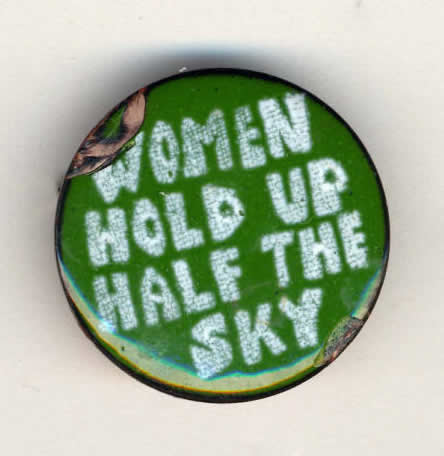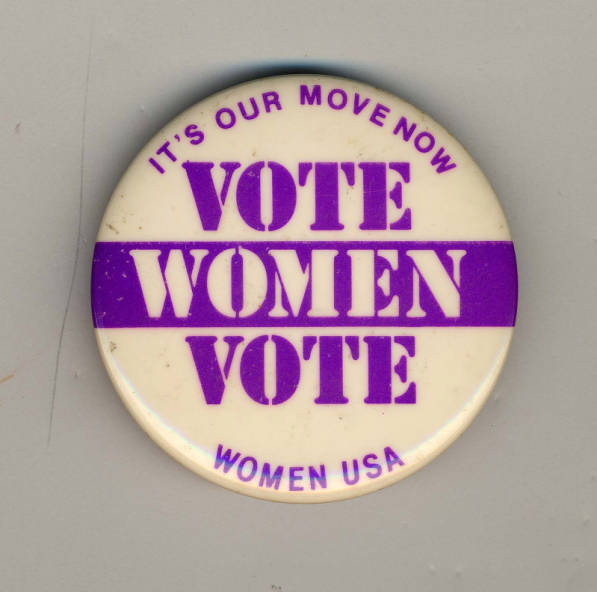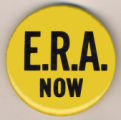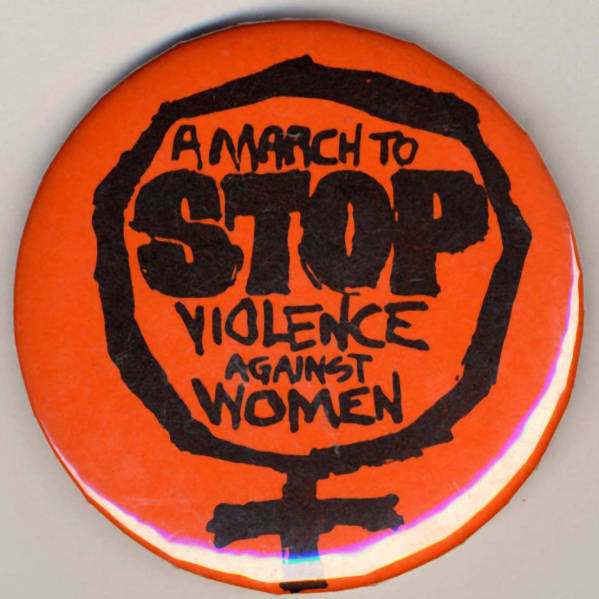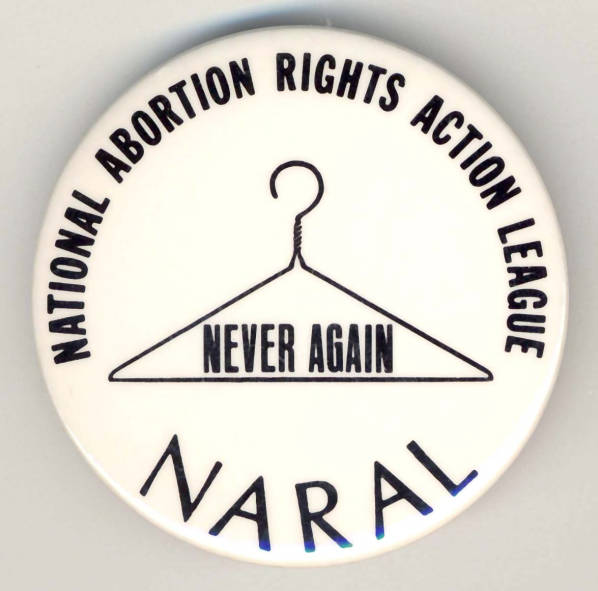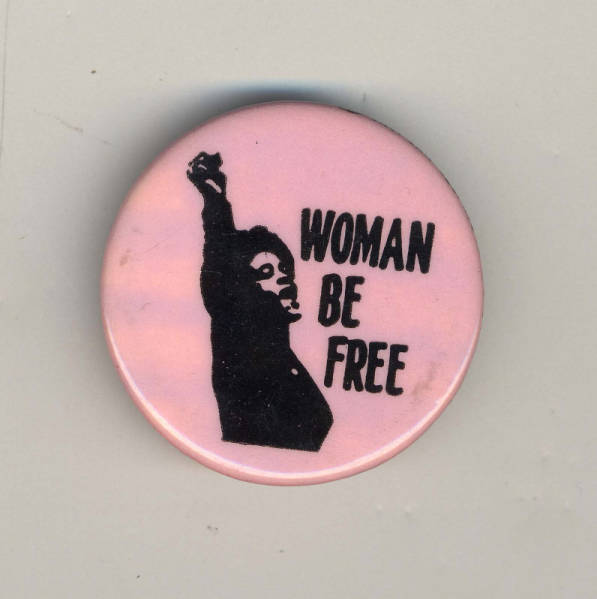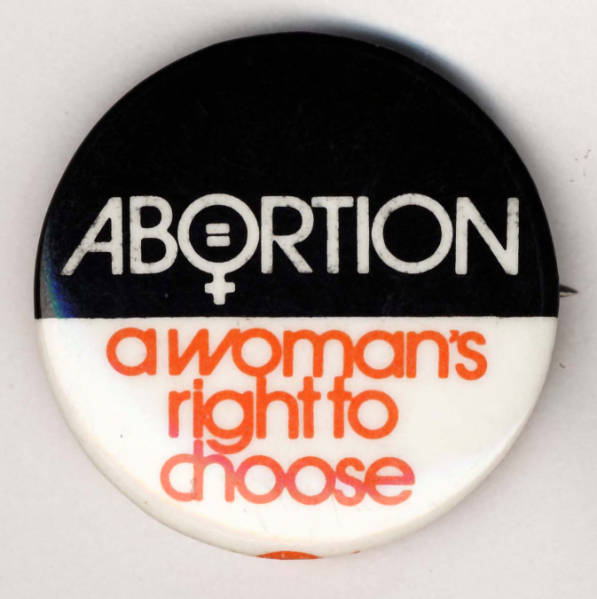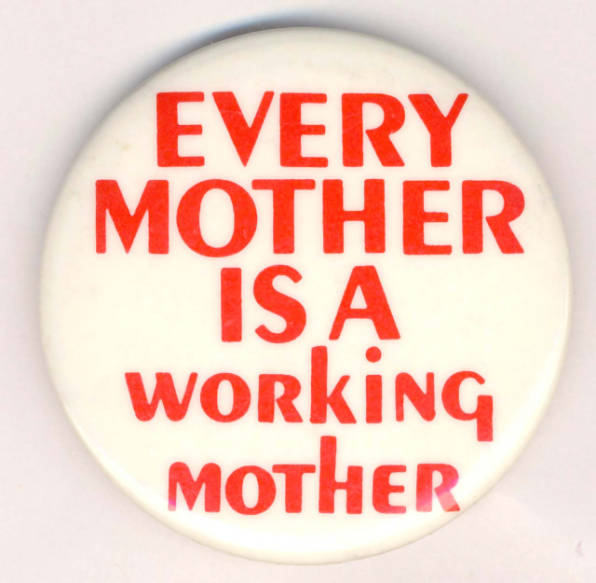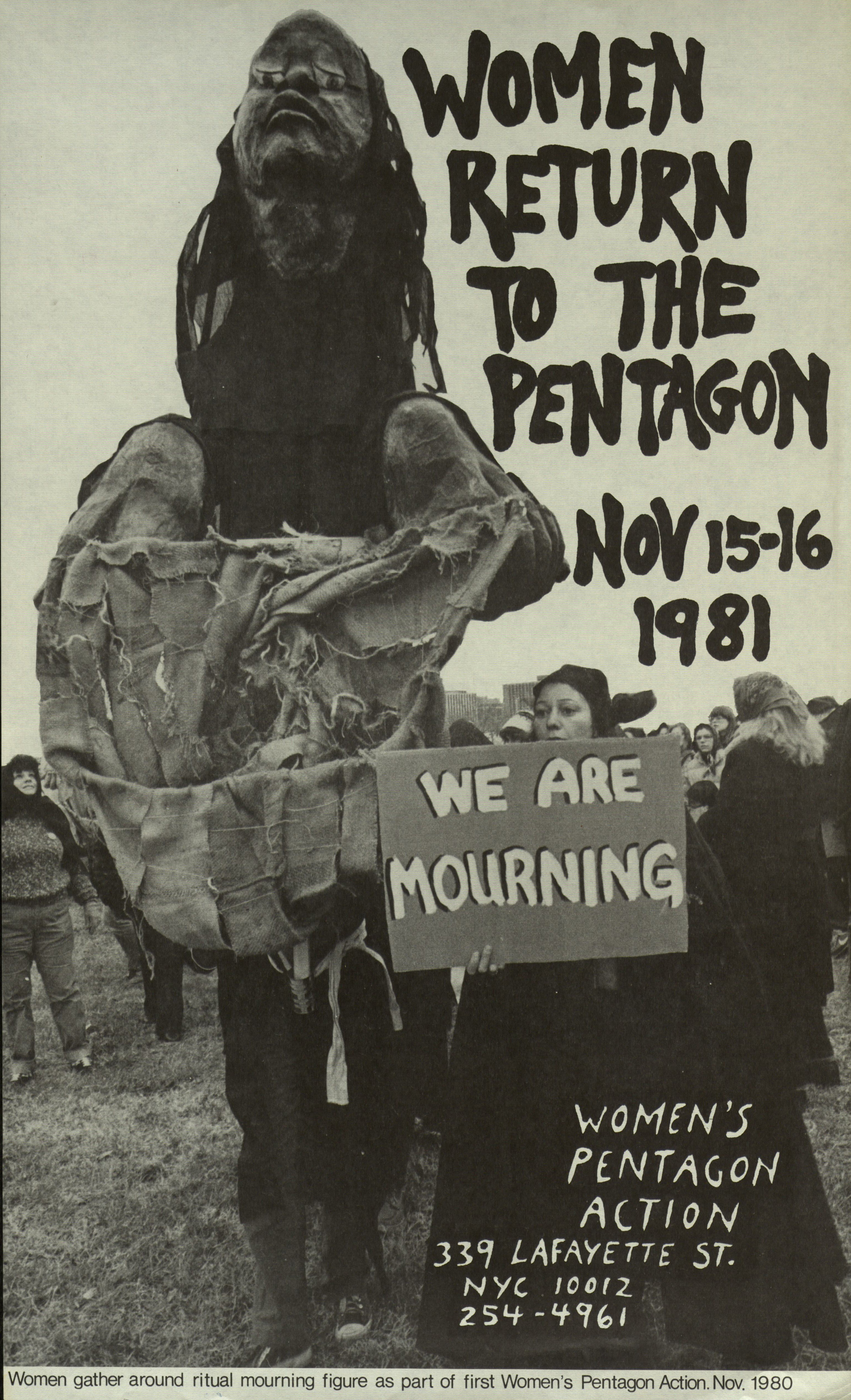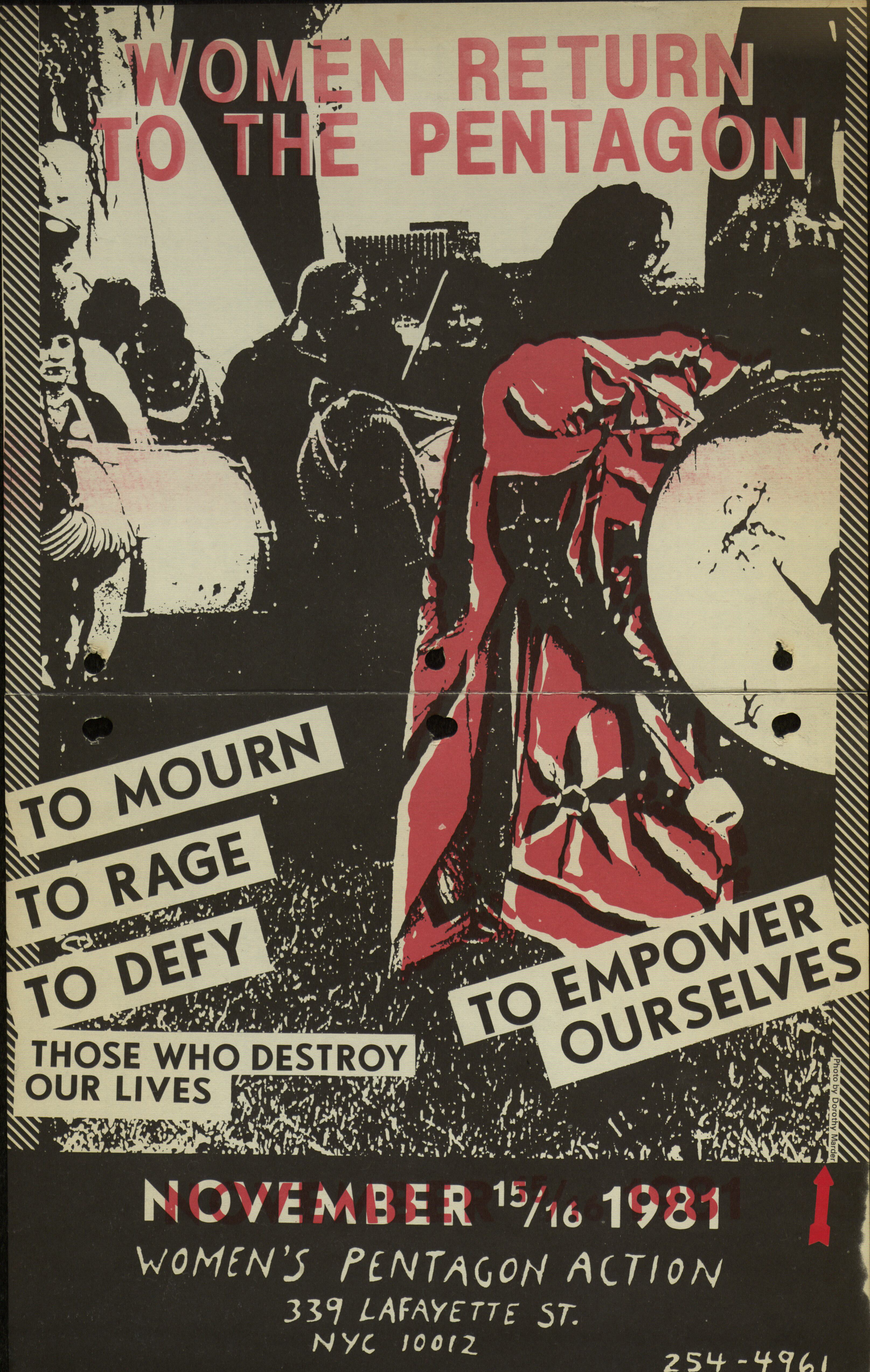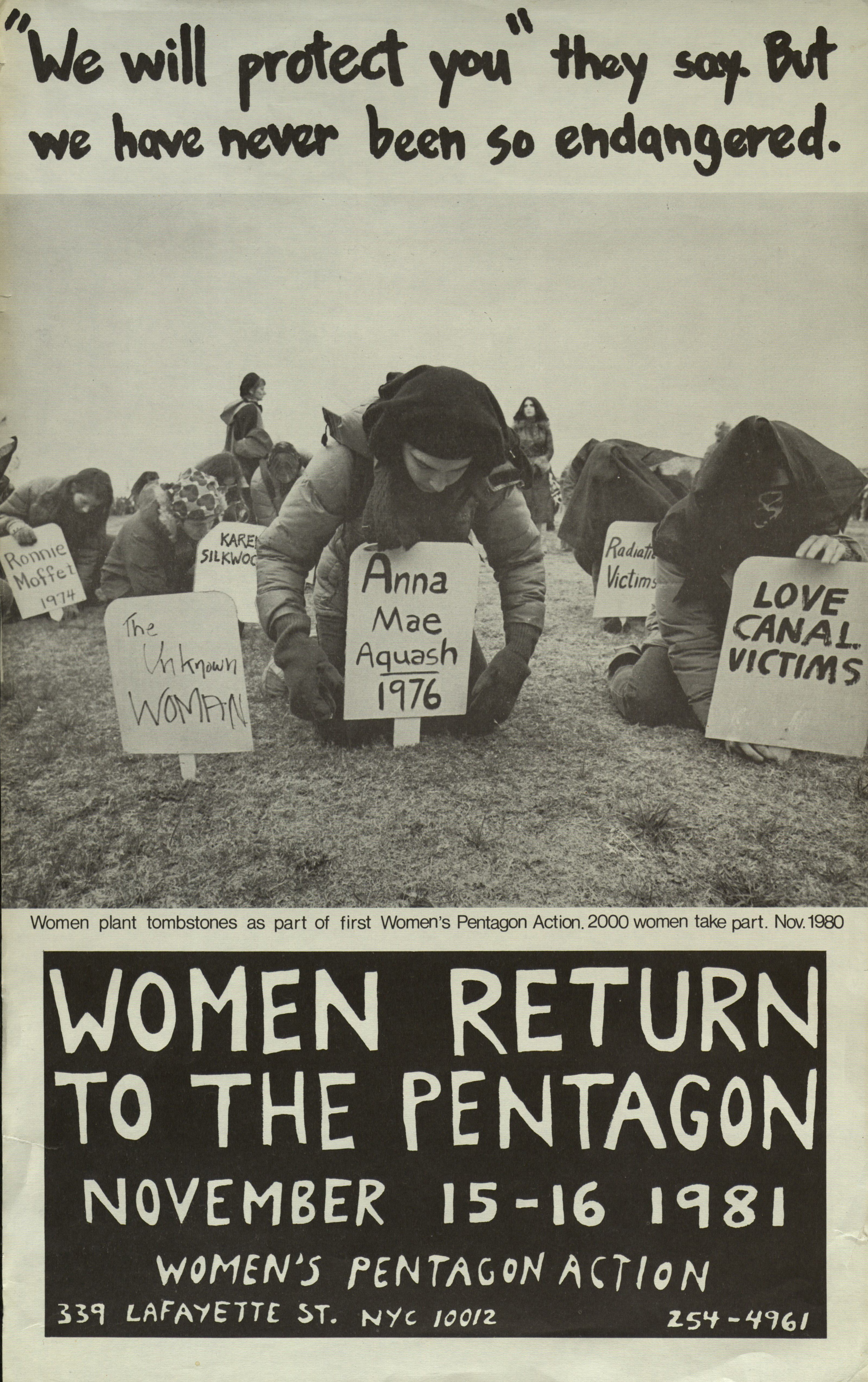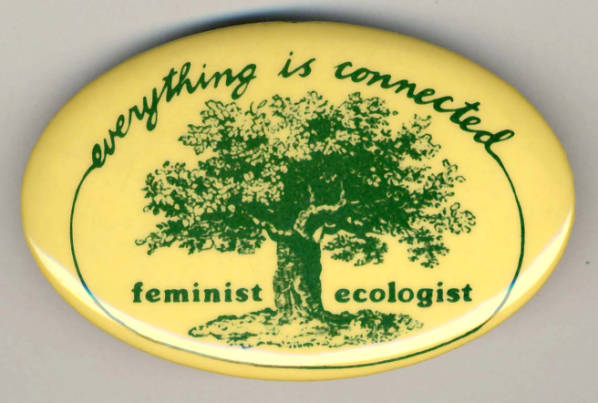Women's Liberation and Peace
National Women's Conference (1977)
Women's Pentagon Action
Abortion Rights Demonstration
Women’s Encampment for a Future of Peace and
Justice (Seneca)
____________________________
Women's Liberation (1960s, 1970s,
1980s)
In the years after World War II increasingly
women entered the paid work force, even after marriage, despite
ubiquitous discrimination and cultural pressures to remain in the home. A
variety of political and cultural shifts in the 1950s revitalized
social awareness of women’s roles and the need for a new emphasis on
women’s rights. President John F. Kennedy’s Commission on the
Status of Women (1960) attempted to document discrimination against
women in the work place. Betty Friedan’s Feminine Mystique
(1963) was one book published early in the 1960s which helped focus
attention on the plight of American women. Friedan’s work a
powerful and controversial book exposing the mass discontent of many
middle-class women and challenged post-war ideas of domesticity.
Feminists who had long fought for the Equal Rights Amendment and other
rights for women were able to lobby successfully for the inclusion of
Title IX in the Civil Rights Act of 1964. Title IX was a huge
victory for women’s rights, making it illegal for institutions or
corporations receiving federal funding to discriminate based on sex.
The 1960s were an era of social consciousness, political activism,
reform, and radicalization and women were significant activists in the
growing anti-nuclear movement, the Civil Rights Movement and the
protests against the Vietnam War. Women’s Liberation was a
broad-based movement of radical and progressive women, and fostered
female activism. In 1965, feminists including Betty Friedan,
Gloria Steinem, Flo Kennedy, and many others, founded the National
Organization for Women (NOW), an influential, progressive organization
focused on fighting for equality for women in all aspects of U.S.
society. During the 1970s and early 1980s NOW led the fight for the
Equal Rights Amendment to the federal constitution which would have
outlawed discrimination based on sex. Only 35 out of the needed 38
states ratified the amendment, and the ERA did not become law.
Issues women raised in this “Second Wave” of feminism grew to include
equality in education and the workplace, marriage, legalizing abortion
and reproductive rights, questioning of male militarism, and female
sexuality.
More radical feminists, who believed that a transhistorical and
transnational patriarchal system primarily oppressed women were active
on a broad range of issues outside of legislative and institutional
politics, especially after the late 1960s. Throughout this period
Dorothy Marder continued to be active in progressive and radical
feminist circles, as well as more traditional women’s organizations such
as Women Strike for Peace.
Mary C. Lynn, Ed. Women’s Liberation in the Twentieth Century. John Wiley and Sons, Inc. 1975
National Women’s
Conference, Houston Texas 1977
The re-newed fervor of women activists in the 1960s and 1970s
forced the presidential administrations of John Kennedy, Lyndon Johnson,
Gerald Ford, and Jimmy Carter to establish various federal commissions
to explore the issues of equal rights for women. President John F.
Kennedy created a Presidential Commission on the Status of Women in the
1960s, and President Lyndon Johnson appointed a Citizen’s Advisory
Counsel on the status of women. . The United Nations declared 1975
to be “International Women’s Year”; and later declared 1975 to 1985 the
Decade for Women. When he became President, Jimmy Carter appointed
Congresswoman Bella Abzug to head the Commission. Abzug later proposed a
National Women’s Conference.
Two years later, the
first National Women’s Year Conference was held in Houston, Texas.
Women from all 50 U.S. states and territories attended. Notable
women in attendance included Grace Paley, Betty Friedan, Maya Angelou,
Corretta Scott King, Bella Abzug, Margaret Mead, Elizabeth Holtzman, and
among others. Later, Dorothy Marder would write:
It was the first time in
American history that so many women from so many different
backgrounds…were able to assemble together in one place to talk and to
hear each other…We connected with each other in a profound way. (55)
Conservative women
and men were also a presence the Conference, including anti-ERA activist
Phyllis Schlafly and her supporters, pro-life supporters, the Ku Klux
Klan, American Nazi Party, and the all-white delegation from Mississippi
(a state with an African American population of over 36% in 1970).
A National Plan of
Action was voted on at the Conference proposing action on important
national women’s issues, such as domestic abuse, welfare, Equal Rights
Amendment, disability, minority rights, reproductive rights, and
education. 25 of the 26 resolutions of the National Plan of Action
were passed.
Dorothy Marder
documented this historic event by photographing what she calls, “the
‘ordinary’ woman, who, of course, was extraordinary”(50) who attended
the conference. Attending the Conference was particularly influential
for Marder’s own personal and political growth. She wrote,
“Houston was indeed a turning point for me. Although I had
photographed dozens of conferences in the [19]70’s, this conference had a
very special meaning for me.”(56) Marder was particularly touched by
the testimonies at the Conference of lesbians oppressed “at work, in
school, in the military…fears of being ‘found out’ by husbands during
divorce proceedings… [and] losing their children.” (56) And she
found empowerment at the Conference in the community of women “all
feeling free to be who [they were]” (57).
Marder, Dorothy. “Houston: IWY National Women’s Conference 1977.”Dorothy Marder Collection,Swarthmore College Peace Collection, Folder: Life Experience Portfolio for Fordham University, 1989.
Mississippi Census Data: <http://www.census.gov/population/www/documentation/twps0056/tab39.pdf>
___________________________________
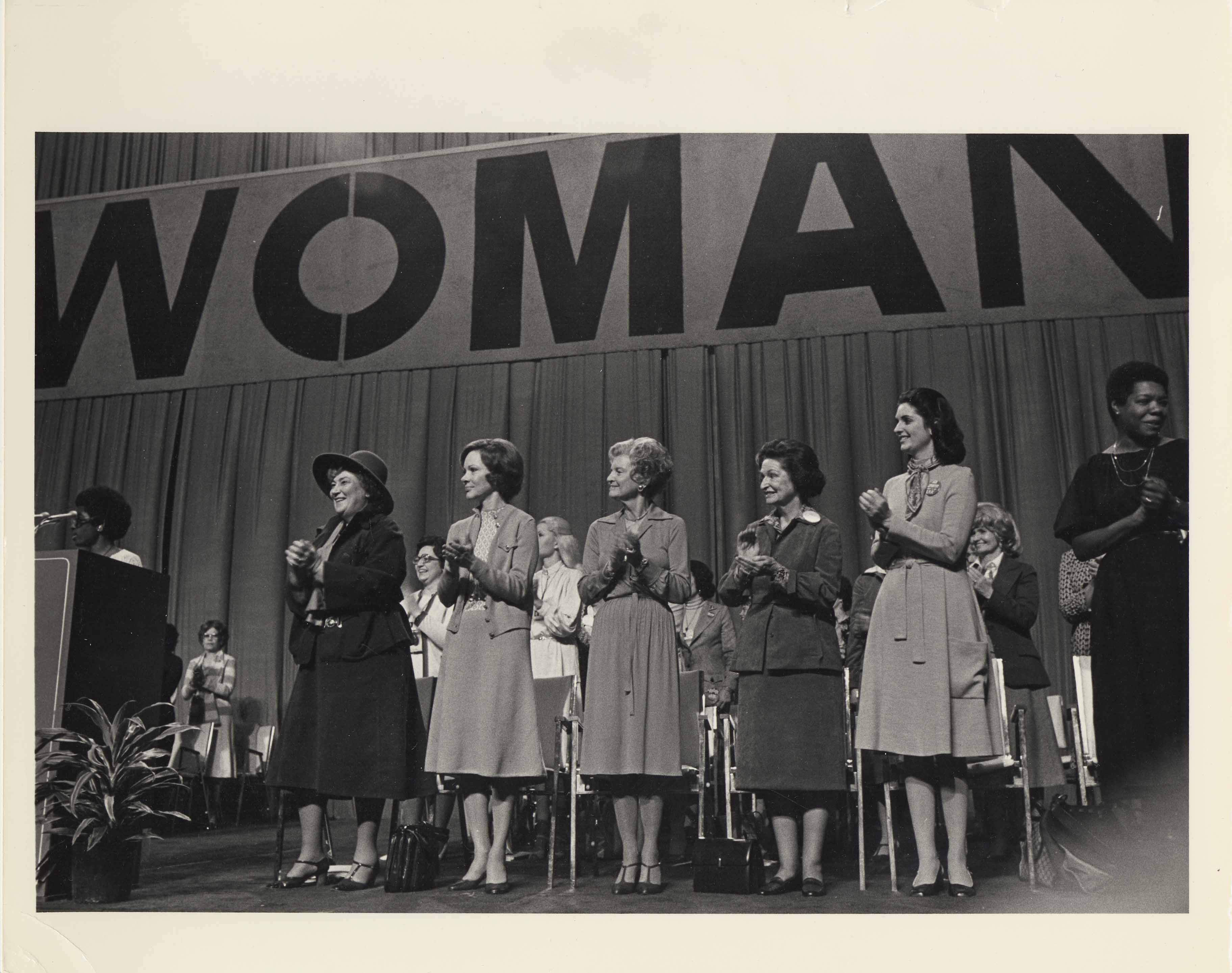
Bella Abzug, Rosaline Carter. Betty Ford, and Lady Bird Johnson, unidentified, Maya Angelou (standing left to right)
Event: International Women Year National Conference
Houston, Texas
November 18-21, 1977
Prints D 715 - 735
6.5" x 9.5"
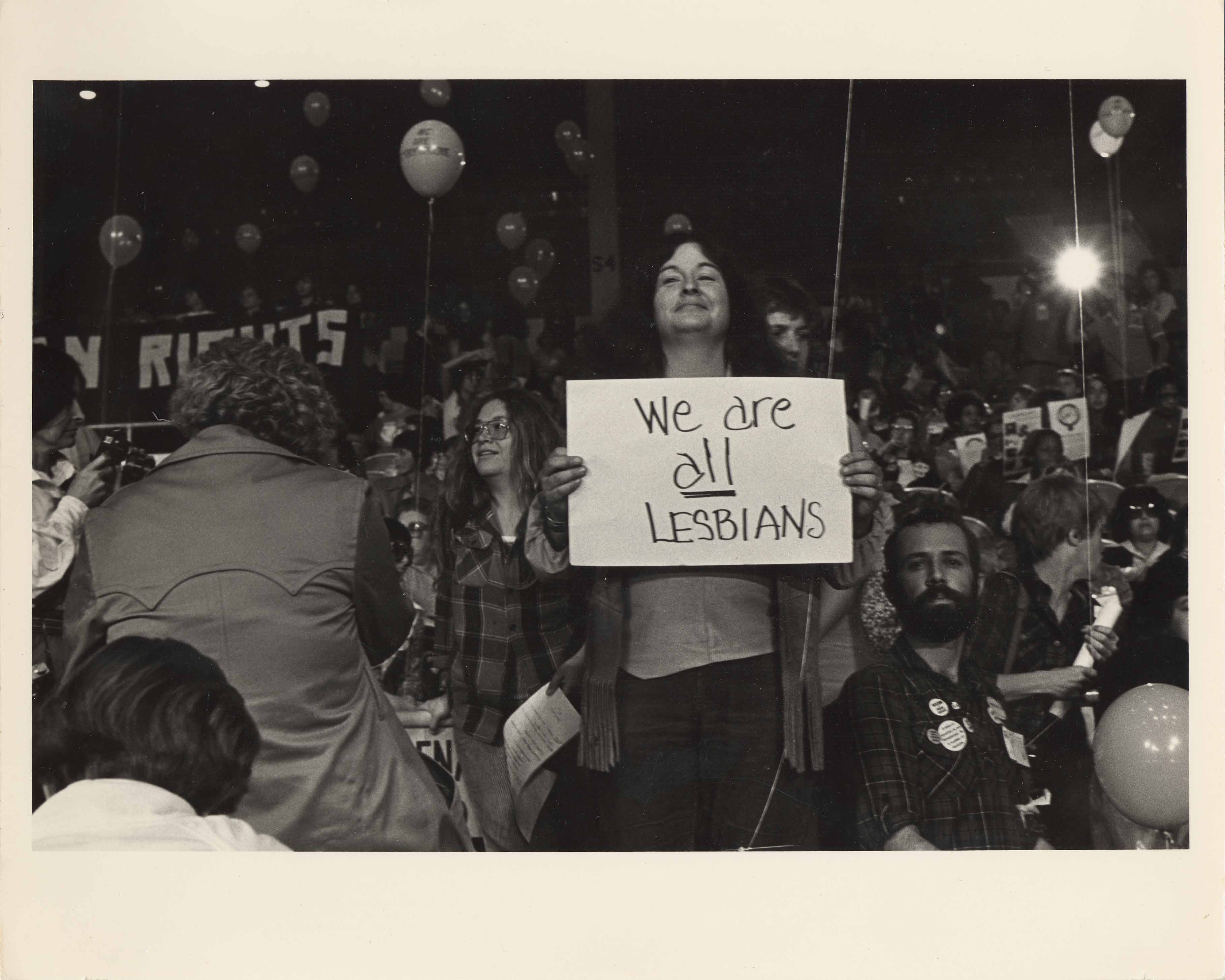
"We are all lesbians"
Event: International Women Year National Conference,
Houston, Texas
November 18-21, 1977
Prints D 715 - 735
6.5" x 9.5"
Note
After the National Women’s Conference (1977)
Marder prepared a spread for a liberal women’s magazine, The
Feminist Bulletin, and included this photograph. However, the
editor objected to publishing this image because of its homosexual
content. Marder, in turn, refused to let her other photographs
from the Conference be published without this photograph.
Marder explained to the editor that the word lesbian had been used to
oppress all women, who “allowed [themselves] to be strong, independent,
assertive, and yes, aggressive.” (57) To embrace the word
lesbian is empowering for all women because at its core it
means a woman who loves other women (57). This withdrawal of her
photography was Marder’s first public act for lesbian rights and an
early coming out experience for Dorothy Marder herself.
Marder, Dorothy. “Houston: IWY National Women’s Conference 1977.”Dorothy Marder Collection,Swarthmore College Peace Collection, Folder: Life Experience Portfolio for Fordham University, 1989.
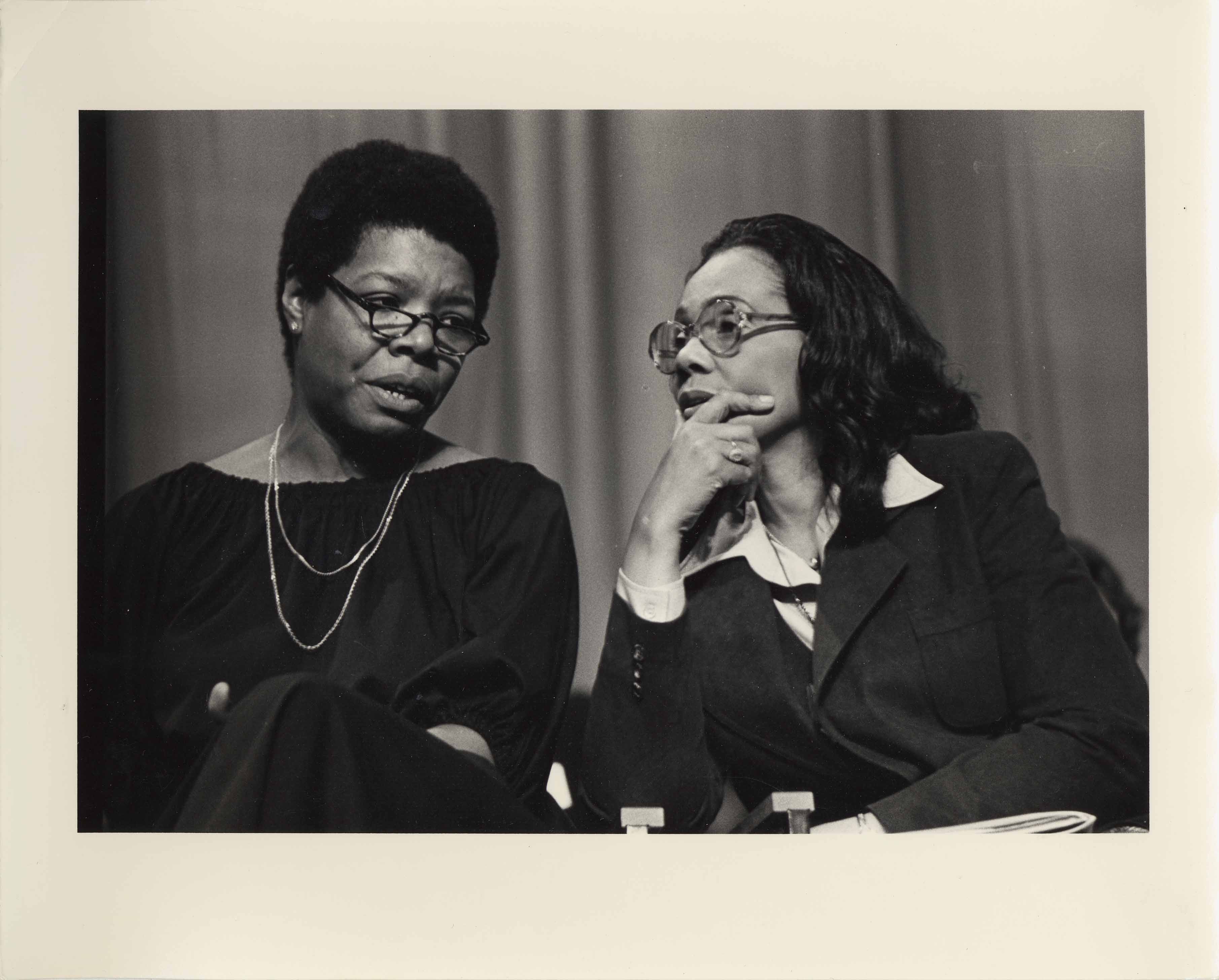
Maya Angelou and Coretta Scott King
Event: International Women National Conference,
Houston, Texas
November 18-21, 1977
Prints D 715 - 735
6.5" x 9"
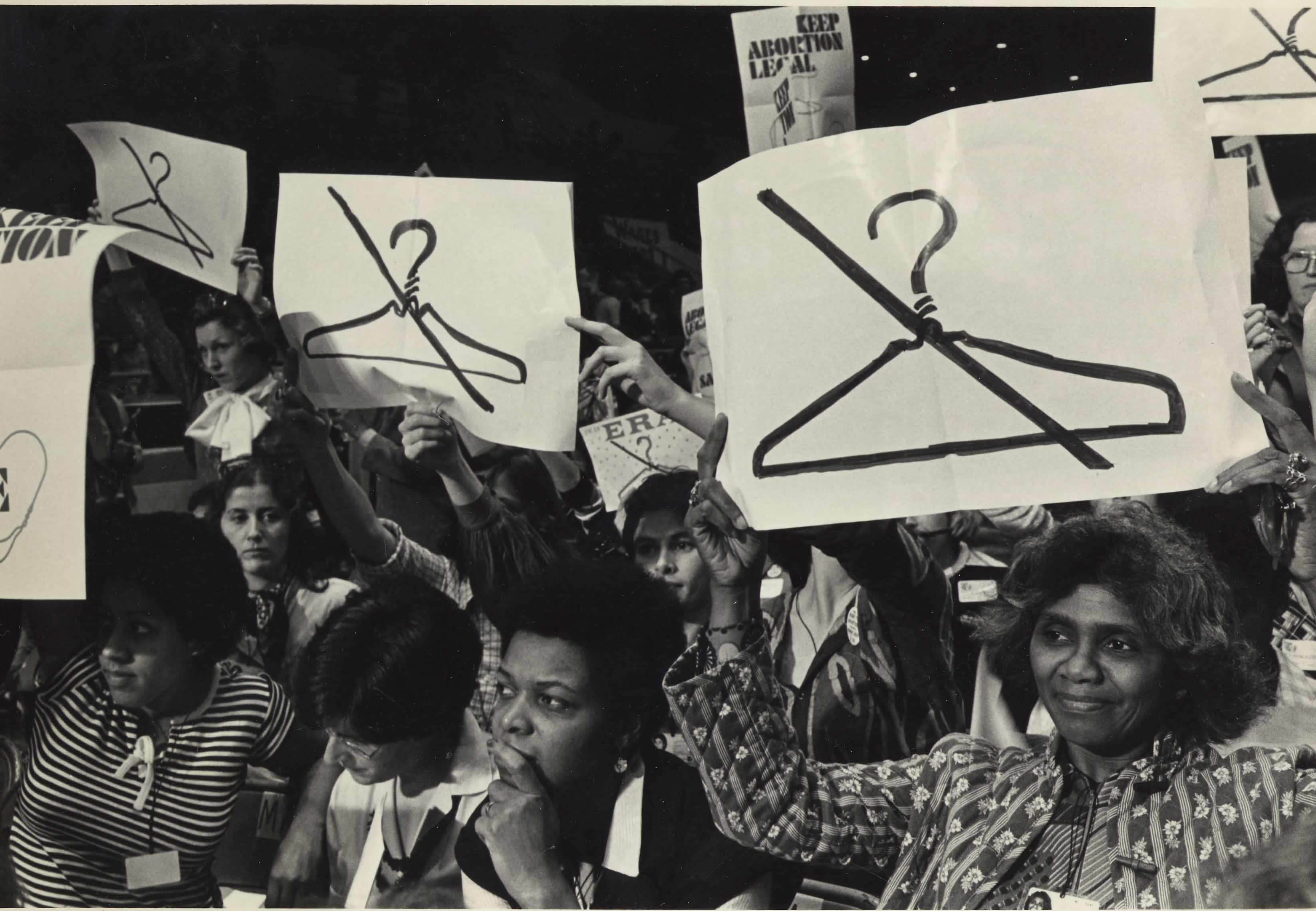
Event: International Women Year National Conference
Houston, Texas
November 18-21, 1977
Prints D 715 - 735
7.5" x 9.5"
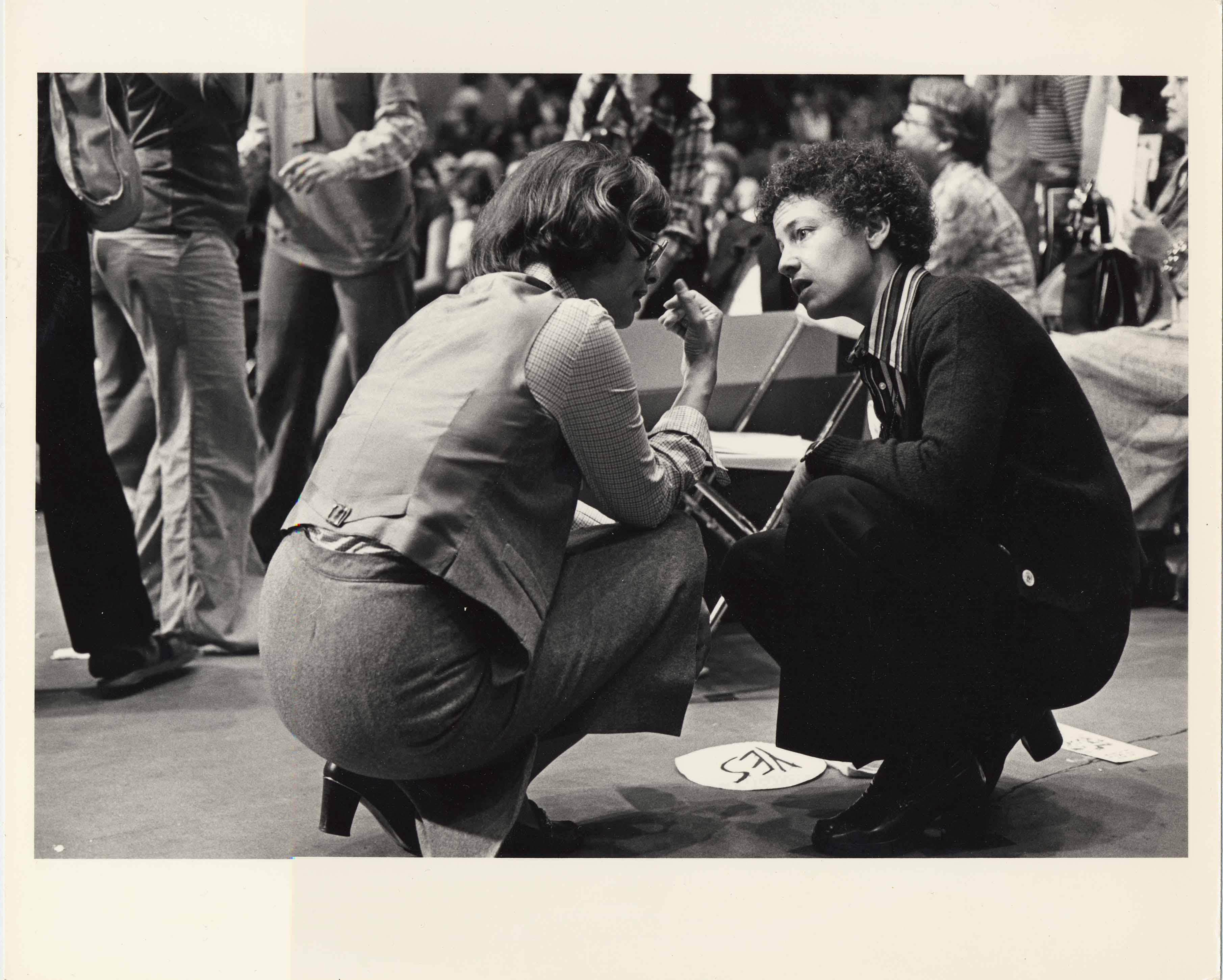
Event: International Women Year National Conference,
Houston, Texas
November 18-21, 1977
Prints D 715 - D 735
7.5" x 9.5"
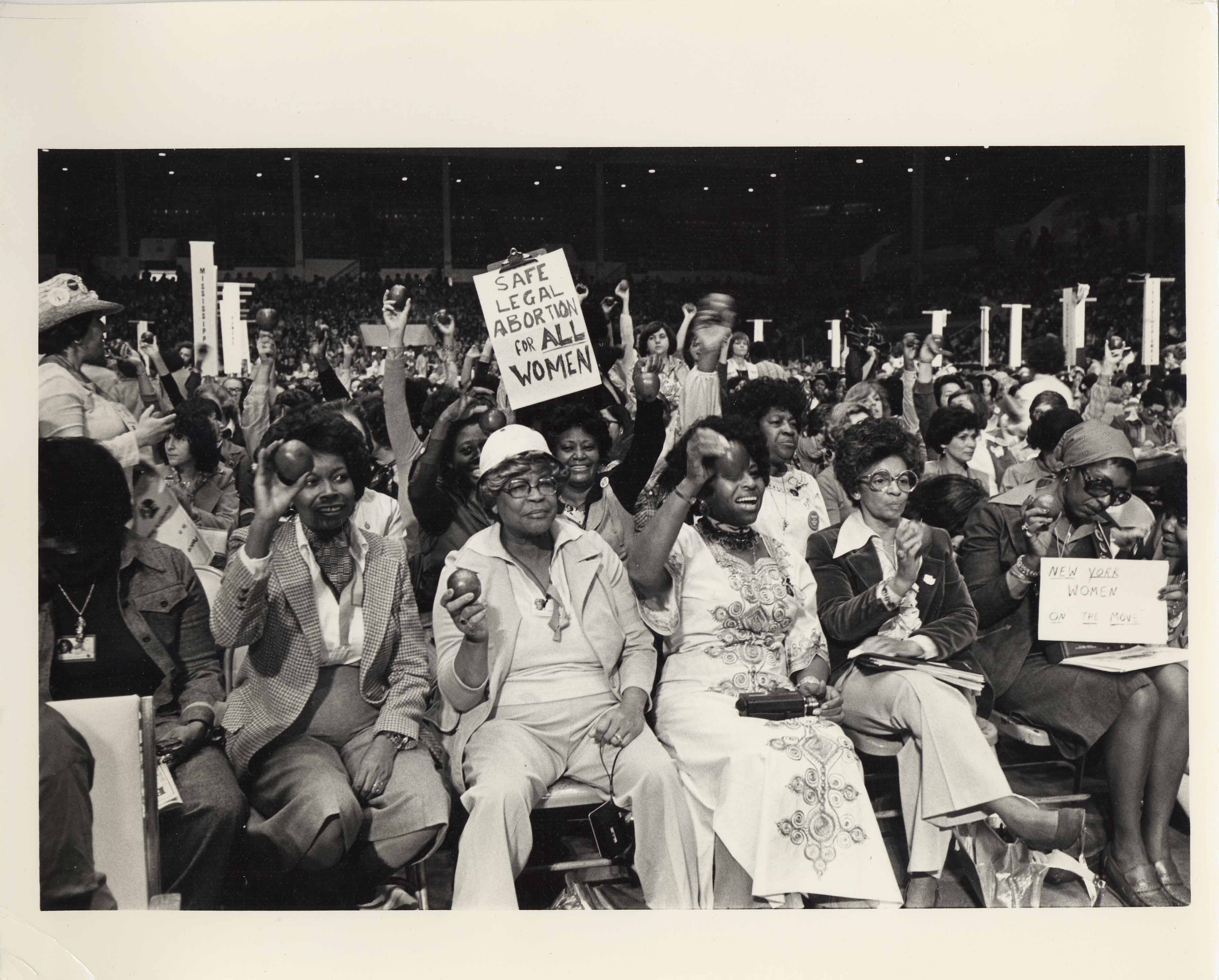
Women From New York
Event: International Women Year National Conference,
Houston, Texas
November 18-21, 1977
Prints D 715 - D 735
6.5" x 9.5"
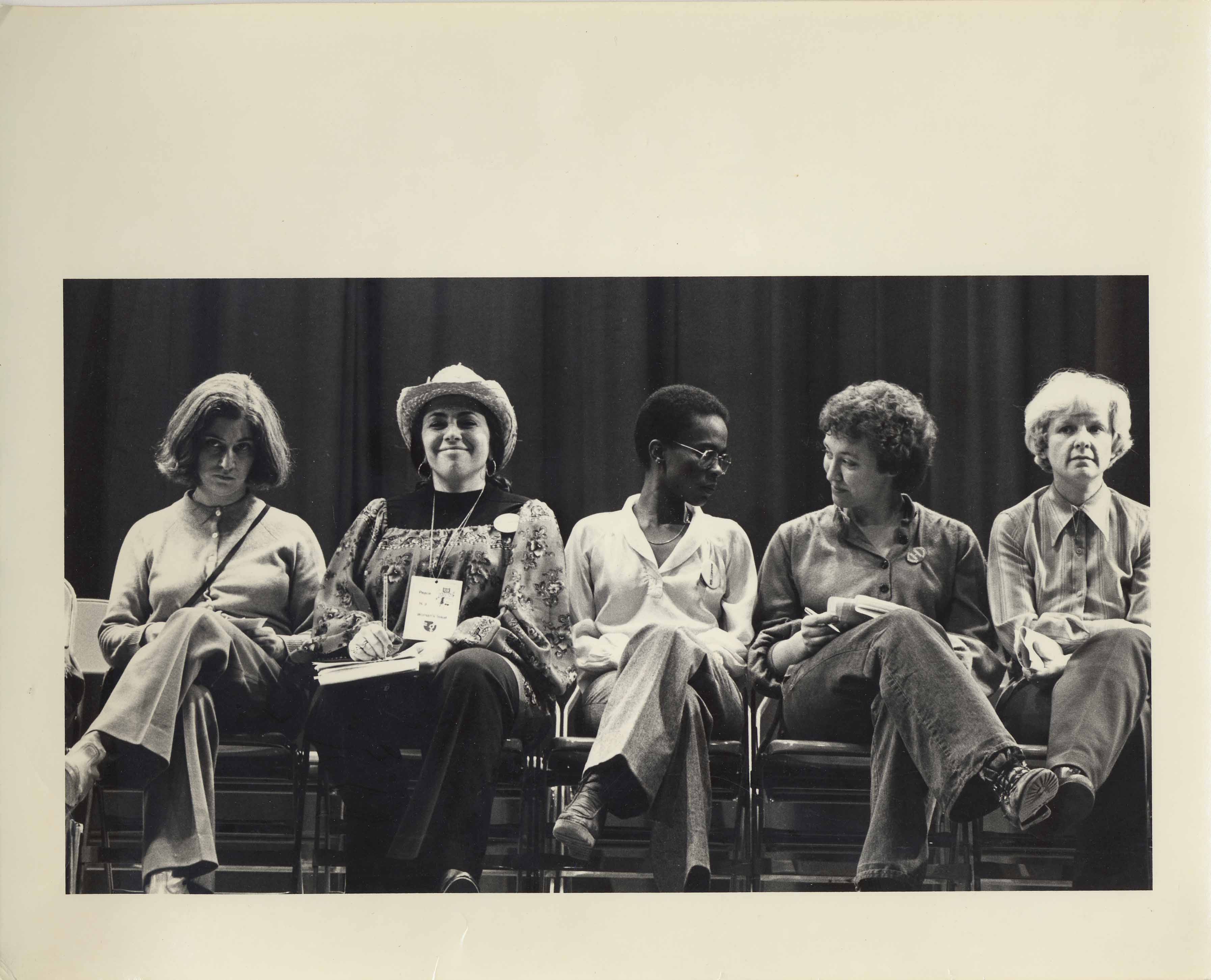
Event: International Women Year National
Conference,
Houston, Texas
November 18-21, 1977
Prints D 715 - D 735
6" x 9.5"
Women’s Pentagon Action
November 1980 and November 1981
The Women’s Pentagon Action (WPA) was an east coast organization founded in the late 1970s by radical feminists who connected the issues of feminism with a gendered analysis of ecology, peace, and militarism. When the U.S. government announced plans to deploy a new generation of nuclear missiles in western Europe capable of reaching Soviet soil within minutes, nuclear war seemed imminent. In response to this escalation in U.S. nuclear policy, feminists organized two protests (in November of 1980 and November 1981), during which hundreds of women surrounded the Pentagon military complex (in Washington, D.C.), attempting to close or disrupt “business as usual.” The members and supporters of the WPA came from women’s liberation groups, were radical feminists, lesbian feminists, peace activists, and ecofeminists.
Street theater, with large puppets and mock tomb stones erected on the front lawn of the Pentagon were some of the powerful tactics employed by the protestors. Women encircled the Pentagon and closed the front gates with string, which symbolized the web of connectedness between all living things that would be destroyed in a nuclear war. Supporters of the WPA wrote one of the first feminist statements connecting the patriarchal oppression of women with war and environmental destruction. Their “Unity Statement” represented the voice of all women and emphasized outrage at the government’s militarism and nuclear policies that threatened all human life and health of the planet. This feminist-organized nuclear protest inspired women around the country, as well as women in Great Britain, to protest U.S. nuclear policies. Notably, two women who attended WPA events returned to England and went on to participate in the organization of the Greenham, England U.S. Air Force base protest. Many women from WPA later took part in the protests at the Women's Encampment for a Future of Peace and Justice in Romulus, New York (see below).
Women’s Pentagon Action Records, Swarthmore College
Peace Collection
Harriet Hyman Alonso. Peace as a Women’s Issue.
Syracuse University Press: Syracuse, NY, 202-210, 221-222. Print.
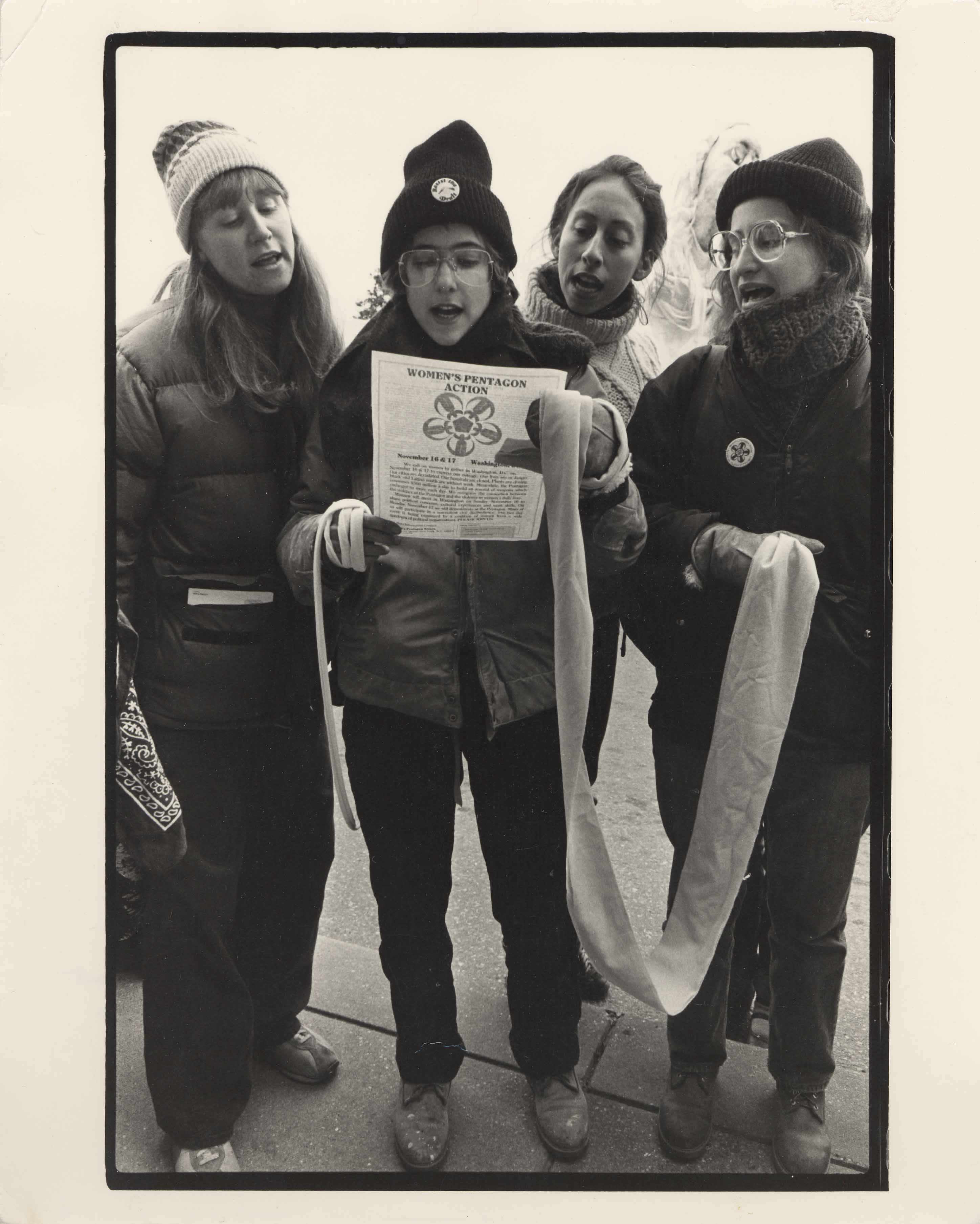
Reading the "Unity Statement"
Event: Women’s Pentagon Action, Pentagon
Washington, D.C.
November 16-17, 1980
Prints D 1030 - D 1042
6.5" x 9.5"
Version
of WPA's "Unity Statement"
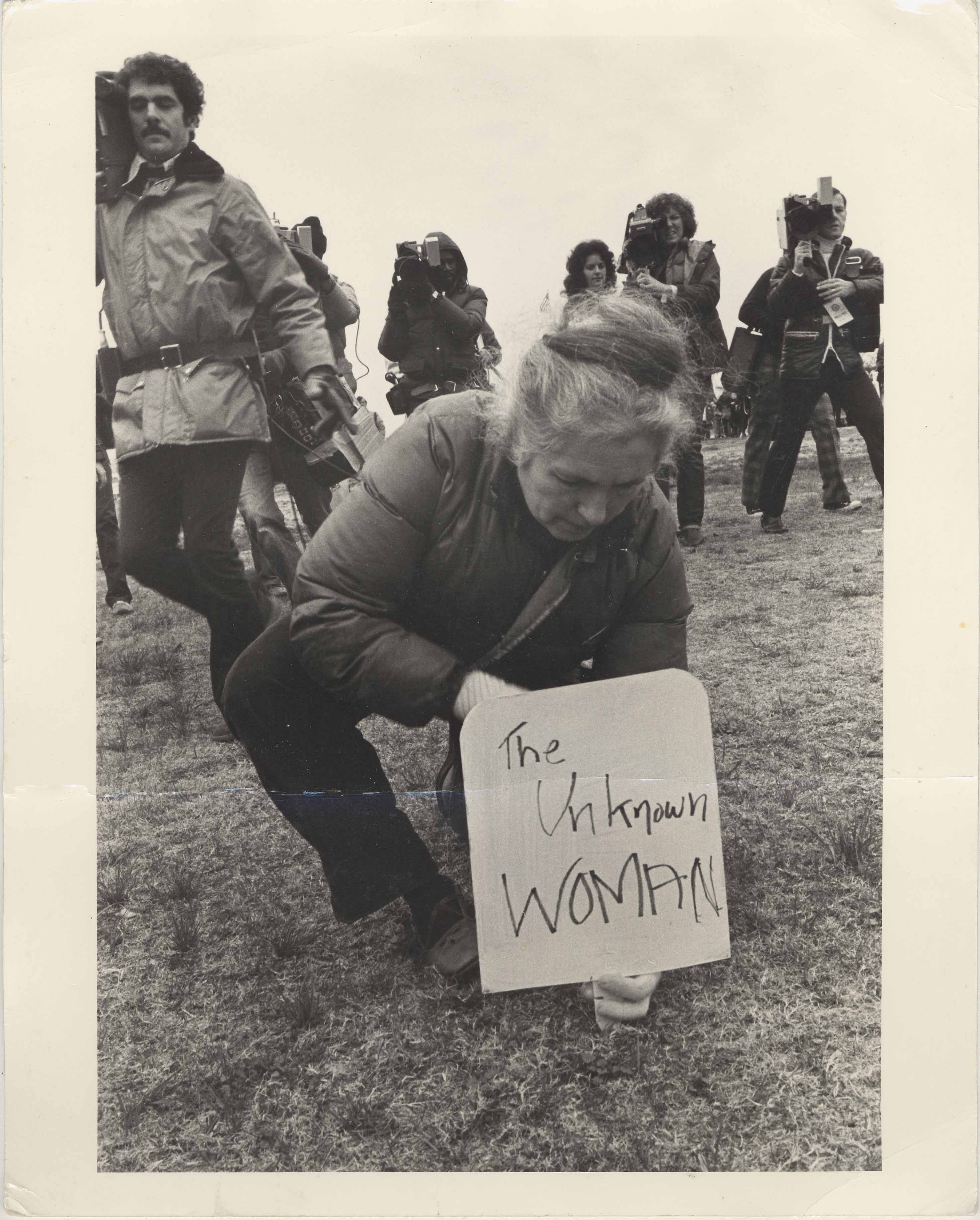
Grace Paley
Event: Women’s Pentagon Action, Pentagon
Washington, D.C.
November 16-17, 1980
Prints D 1030 - D 1042
6.5" x 9.5"
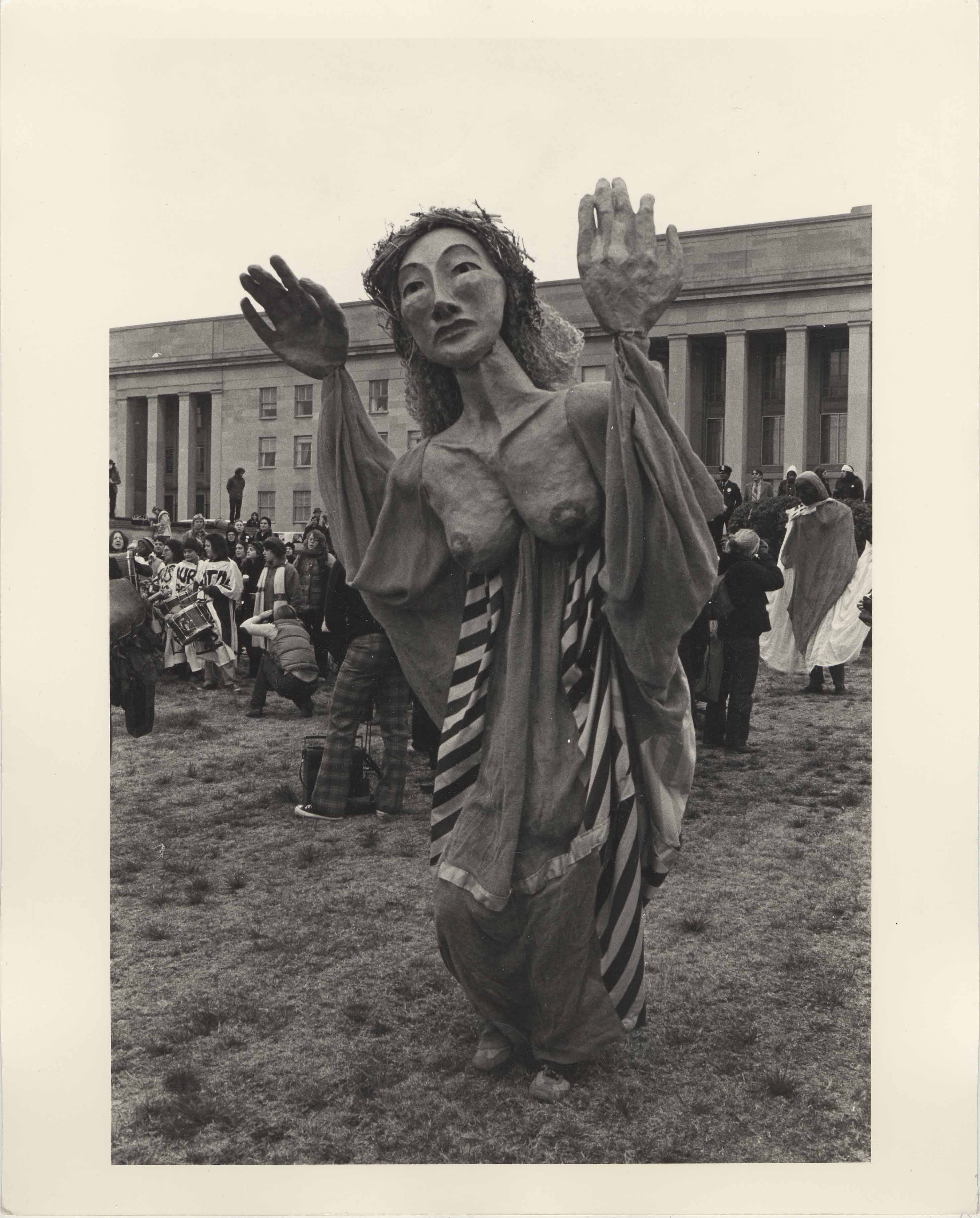
Event: Women’s Pentagon Action, Pentagon
Washington, D.C.
November 16-17, 1980
Prints D 1030 - D 1042
6.5" x 9.5"
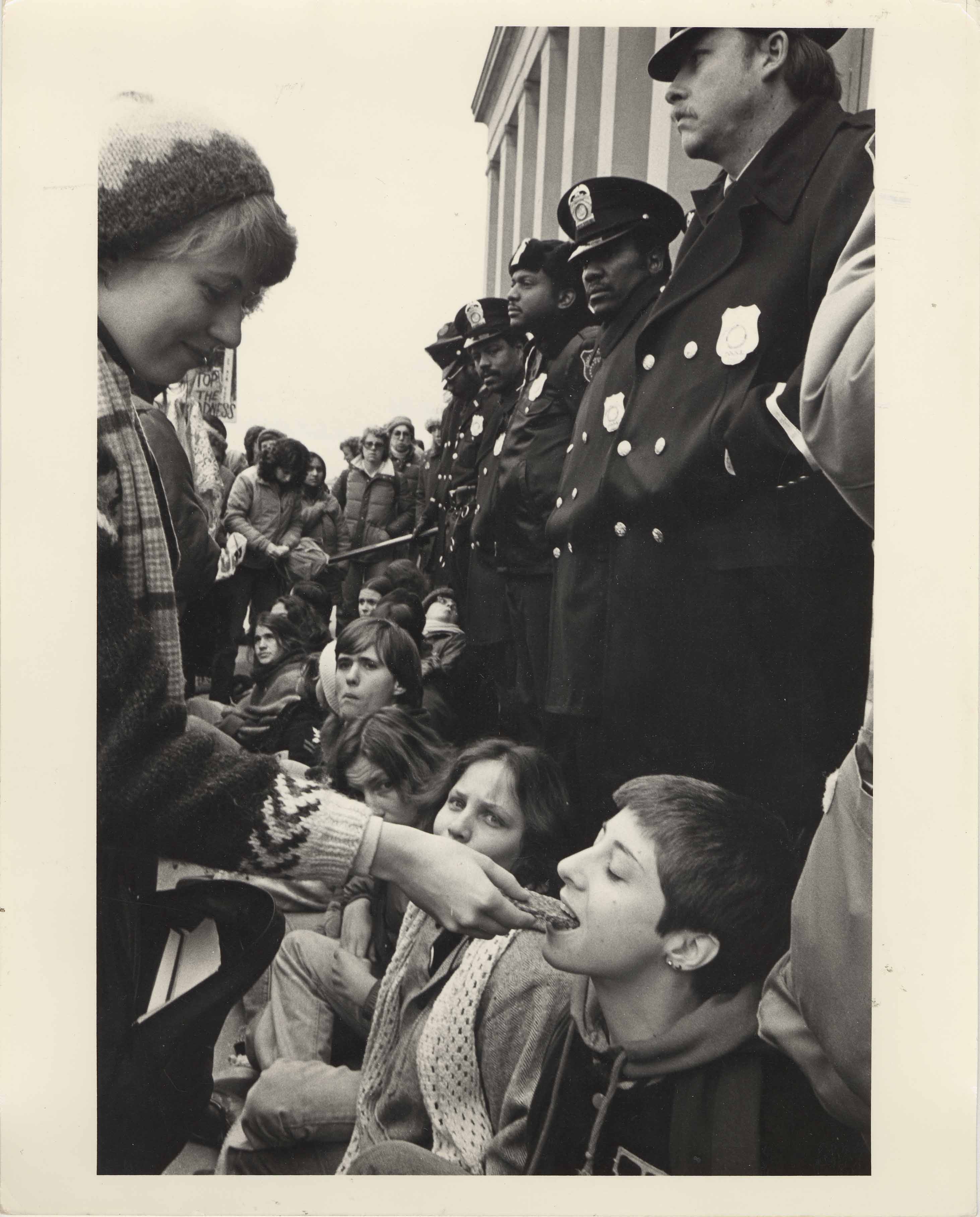
Event: Women’s Pentagon Action, Pentagon
Washington, D.C.
November 16-17, 1980
Prints D 1030 - D 1042
6.5" x 9.5"
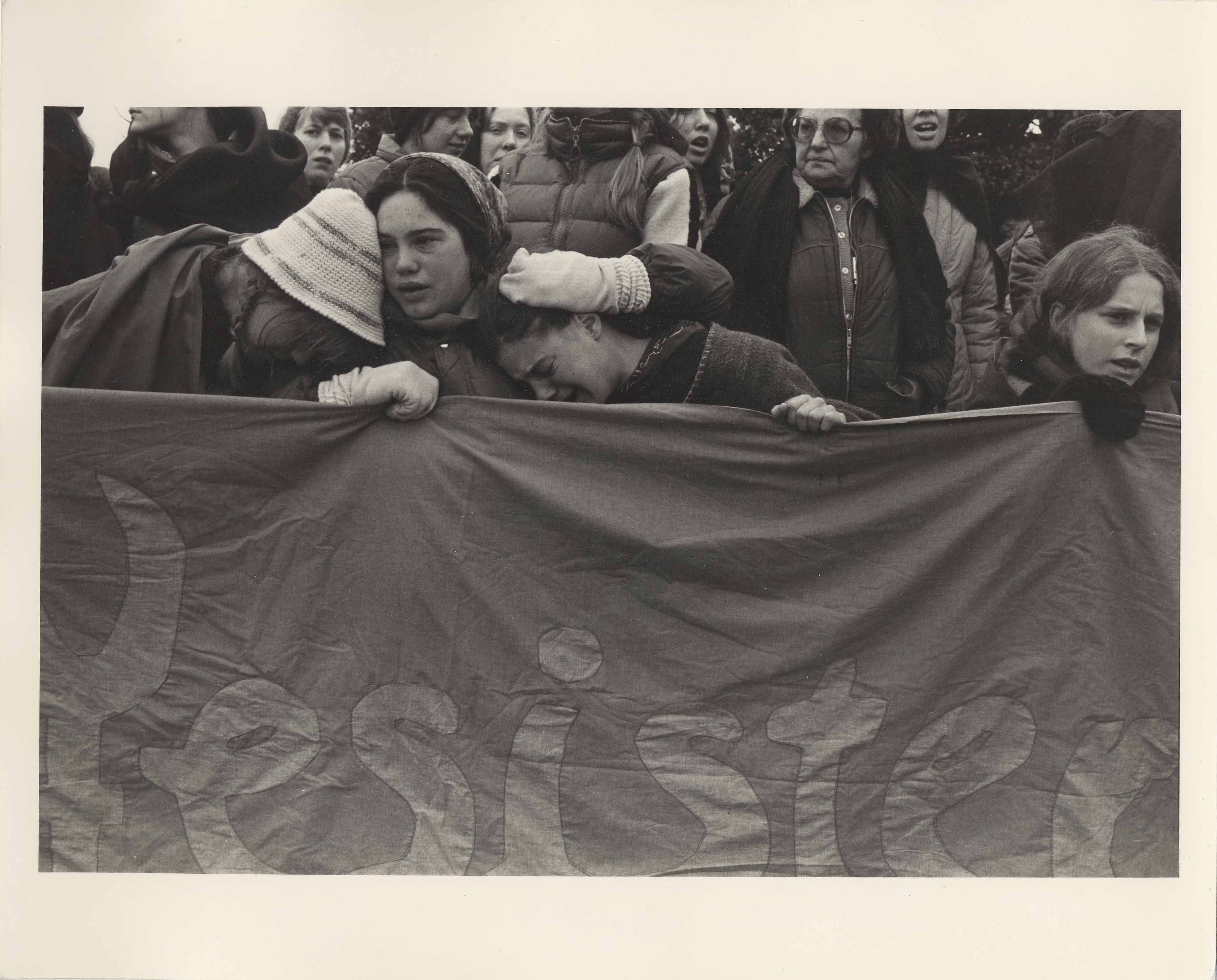
Event: Women’s Pentagon Action, Pentagon
Washington, D.C.
November 16-17, 1980
Prints D 1030 - D 1042
6.5" x 9.5"
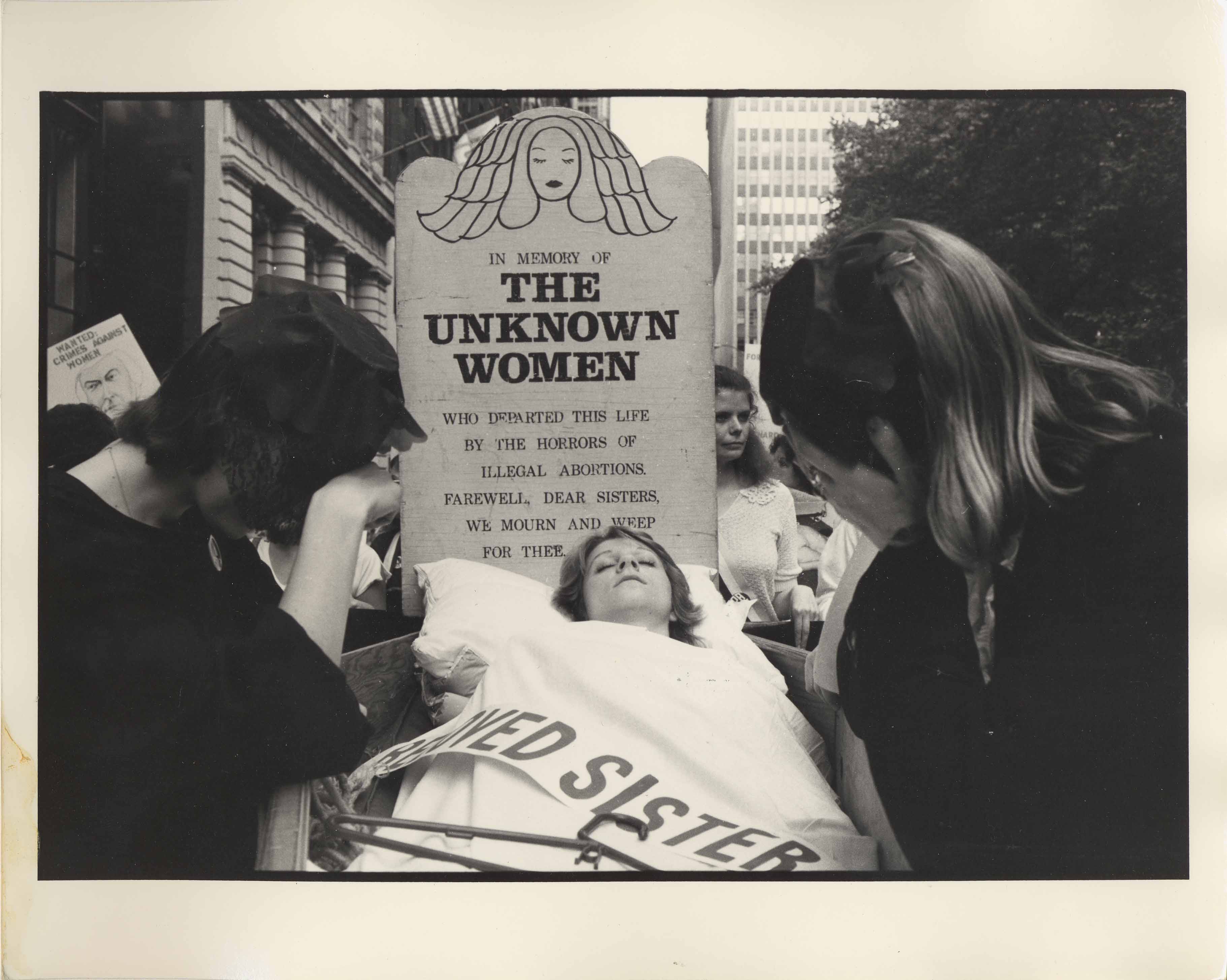
Event: Abortion Rights, March and Rally
Cherry Hill, New Jersey
July 17, 1982.
Prints D 1170 - D 1172
6.5" x 9.5"
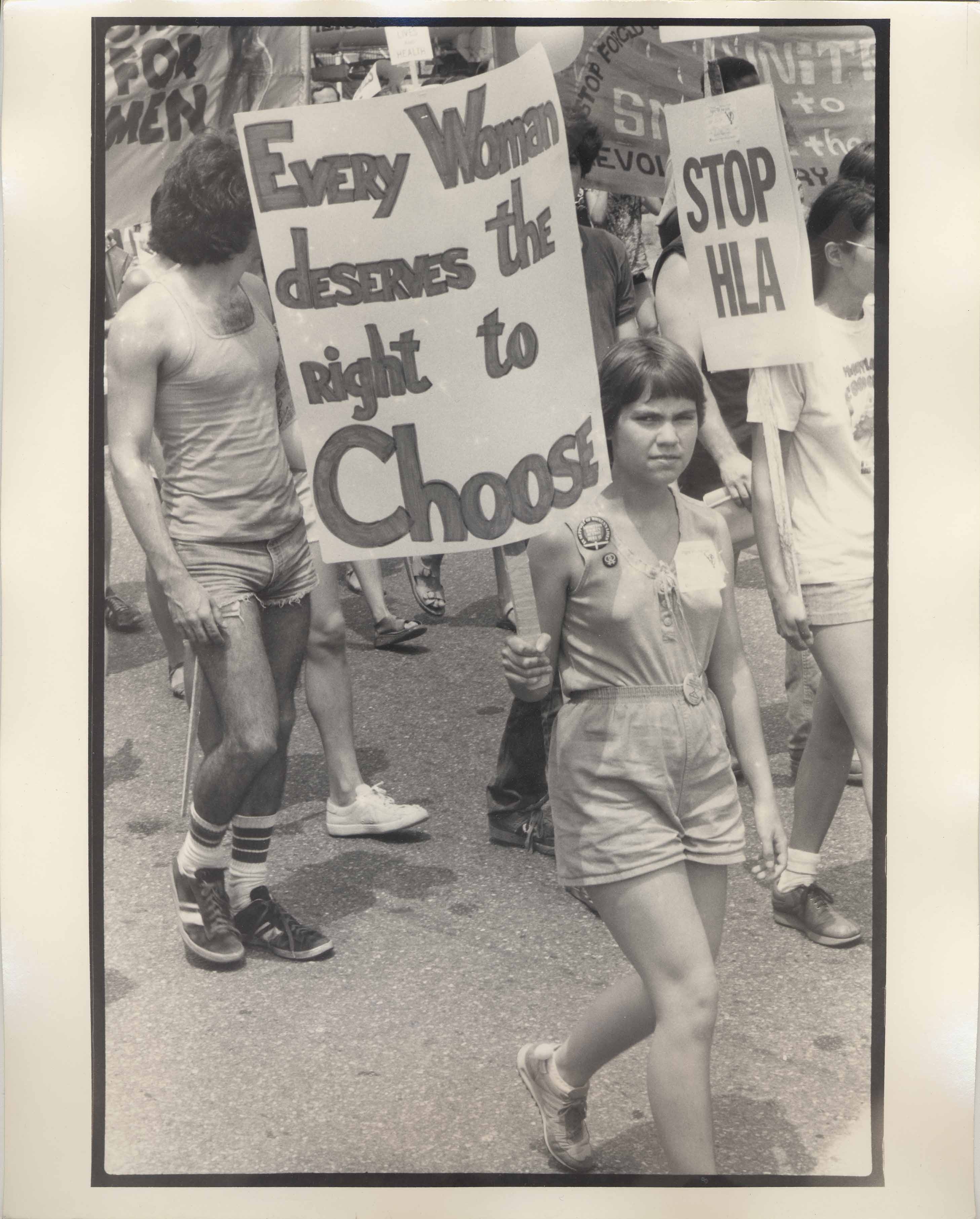
"Every Woman Deserves the Right to Choose" Event: Abortion Rights,
March and Rally
Cherry Hill, New Jersey
July 17, 1982
Prints D 1170 - D 1172
6.5" x 9.5"
 The Seneca Army Depot located in Romulus, New York was a
transshipment facility housing short-range nuclear missiles destined
for deployment in western Europe. Protests by peace activists at
the facility began in the early 1980s. By 1983, feminist peace
activists planned for a summer-long series of protests at the Army
Depot. The women were in part inspired by the 1981 march, and
subsequent long-term women’s camp protesting at the U.S. Air Force base
at Greenham Common, England.
The Seneca Army Depot located in Romulus, New York was a
transshipment facility housing short-range nuclear missiles destined
for deployment in western Europe. Protests by peace activists at
the facility began in the early 1980s. By 1983, feminist peace
activists planned for a summer-long series of protests at the Army
Depot. The women were in part inspired by the 1981 march, and
subsequent long-term women’s camp protesting at the U.S. Air Force base
at Greenham Common, England.
In the summer of 1983, thousands of women from diverse backgrounds
and various peace and feminist organizations came together to set-up an
all-women’s peace camp on purchased land next to the Depot in
Romulus. These feminists connected militarism with a patriarchal
assault on the environment and human life. The peace camp was
known to the activists as “Seneca”.
Women went to the
Seneca peace camp both to protest nuclear missiles and to live in
feminist community. They valued environment, peace, cooperation,
and unity and saw the possibility of creating an alternative to male
patriarchal and militaristic society. Protests included jumping
fences to invade the Seneca Army Depot base itself and directly challenging the U.S.
military with a constant oppositional presence.
The sense of community
fostered at Seneca had a lasting impact for many of the women who spent
summers at the peace camp. The camp, drawing in
thousands of women for a few days or forthe whole summer was run
cooperatively; all of the women were responsible for maintaining
sanitation, food preparation, and logistics. The protests,
political discussions, and community building inspired many women to
carry their feminism and political activism into many other
arenas. Women remained at the camp protesting the nuclear weapons
throughout the 1980s.
In 1995, the encampment
was turned into a retreat center and women’s community called Women’s
Peace Land. As of 2010 Women’s Peace Land reverted to the local
county government for unpaid back taxes. The Seneca Army Depot
closed in 2000 and the land was transferred to the Seneca County
government.
Literature cited:
Wendy E. Chmielewski, “Resisting Nuclear Madness: The Utopian
Vision of the Women’s Encampment for a Future of Peace and Justice,”
[unpublished paper], Rutgers Center for Historical Analysis, 2001.
For more information, please visit Swarthmore
College Peace Collection Resources:
http://www.swarthmore.edu/library/peace/peacewebsite/scpcWebsite/Documents/
ResourcesPeaceHistory.htm#Womens
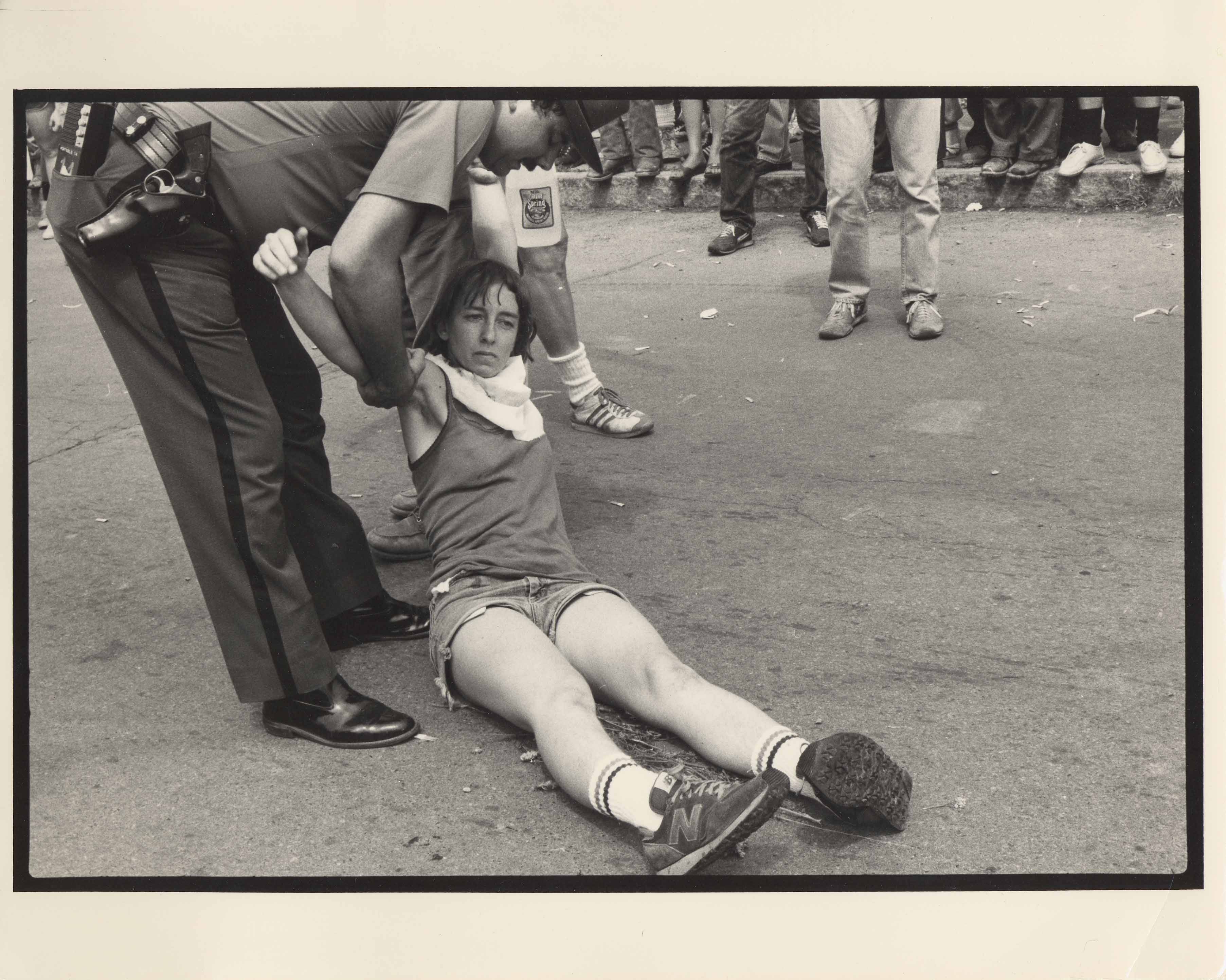
Event: Women’s Encampment for a Future of Peace and Justice
Seneca Army Depot, Romulus, New York
August 1, 1983
Prints D 1250 - 1274
6.5" x 9.5"
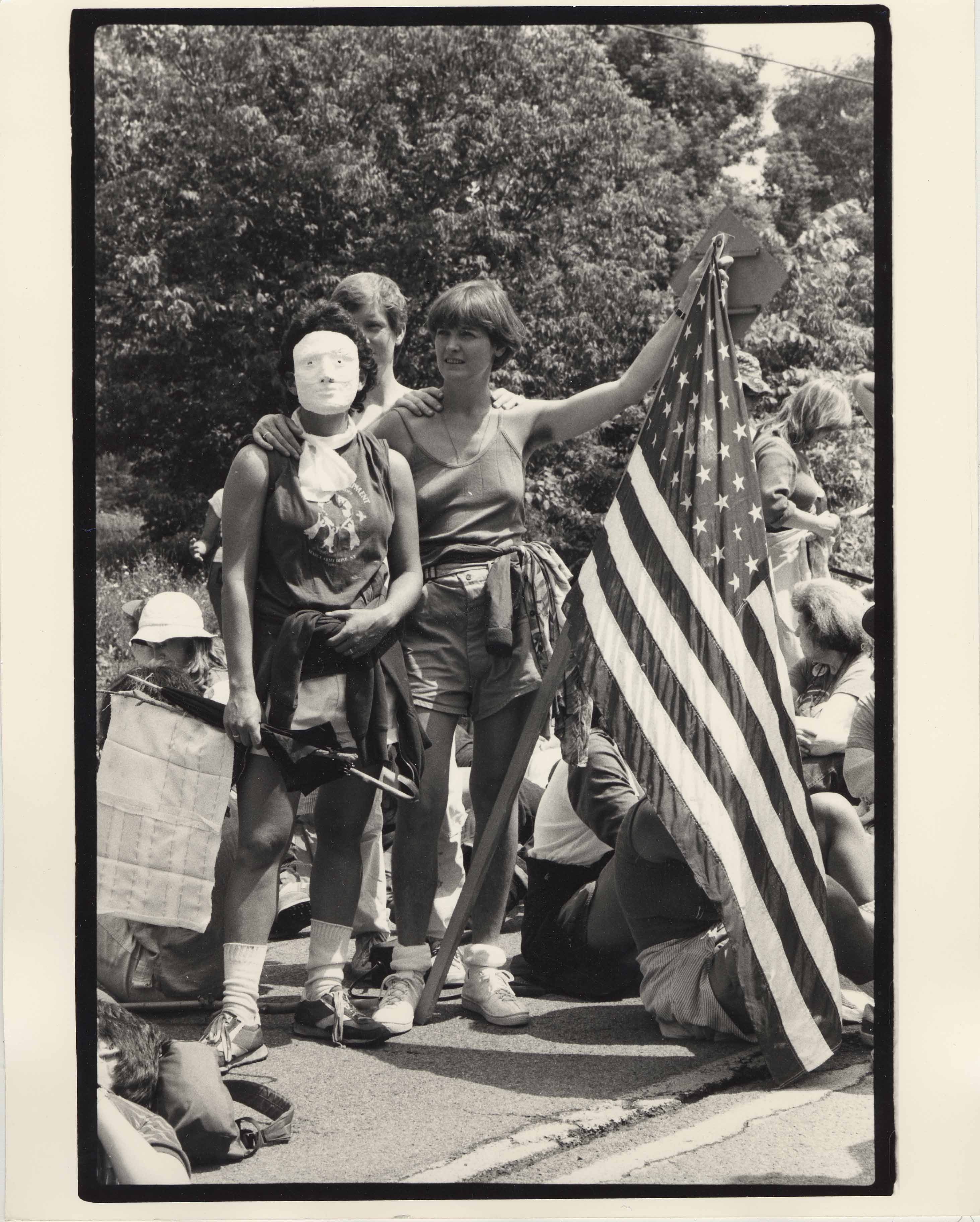
Event: Women’s Encampment for a Future of Peace and Justice
Seneca Army Depot, Romulus, New York
August 1, 1983
Prints D 1250 - 1274
6.5" x 9.5"
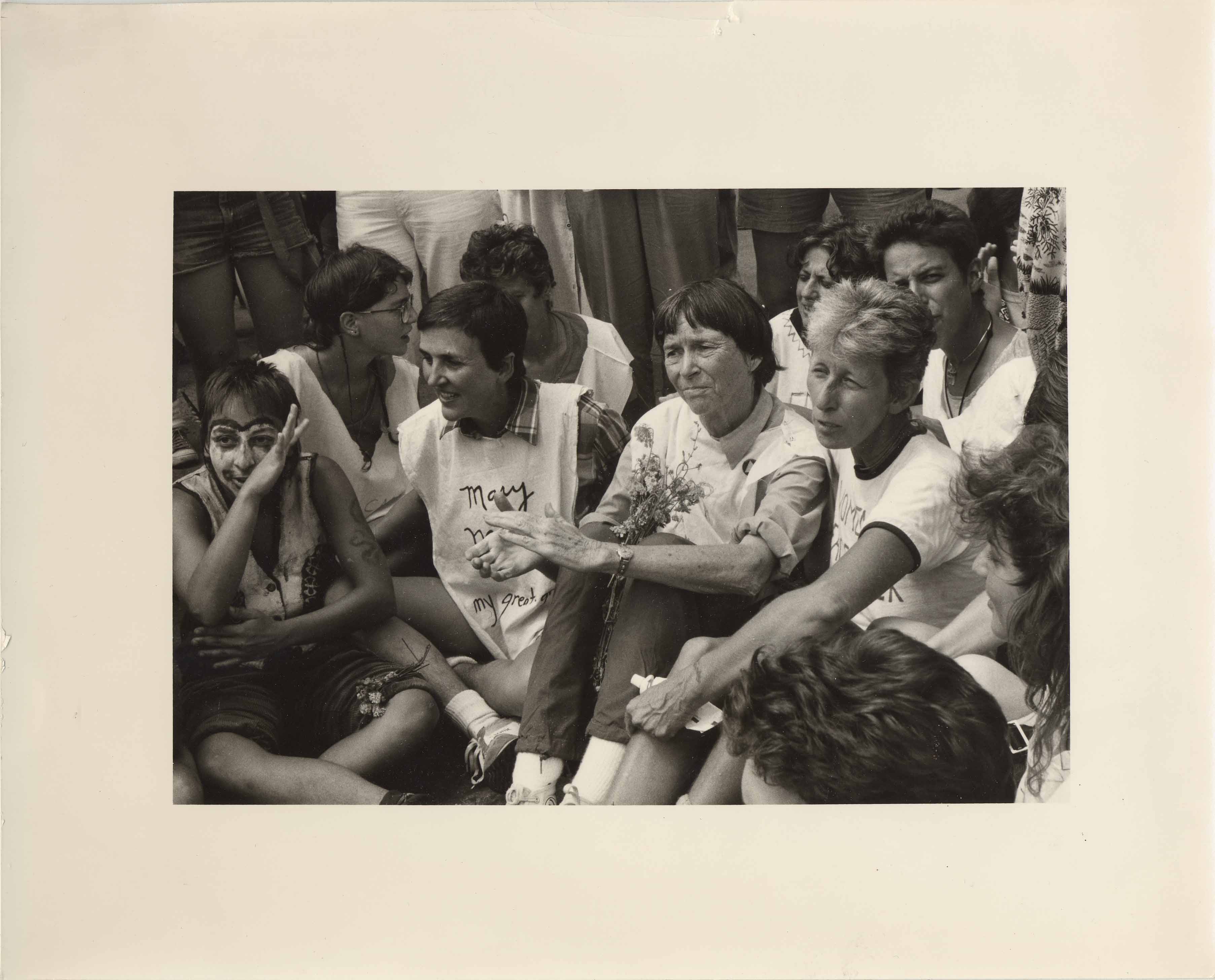
Barbara Deming (seond from right), Blue Lundi (far right)
Event: Women’s Encampment for a Future of Peace and Justice,
Seneca Army Depot, Romulus, New York
August 1, 1983
Prints D 1250 - 1274
7.5" x 9.5"
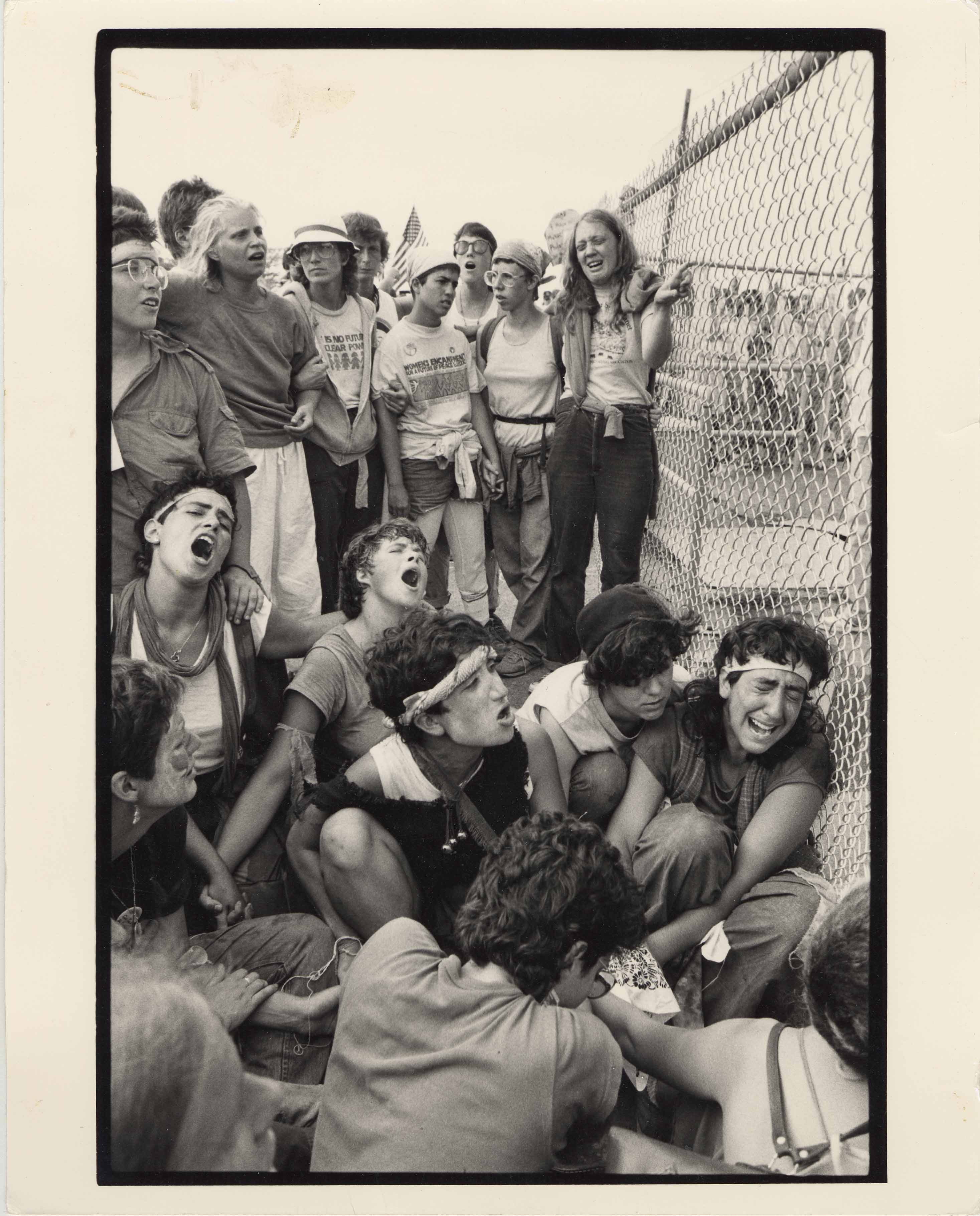
Event: Women’s Encampment for a Future of Peace and Justice,
Seneca Army Depot, Romulus, NY
August 1, 1983
7.5" x 9.5"
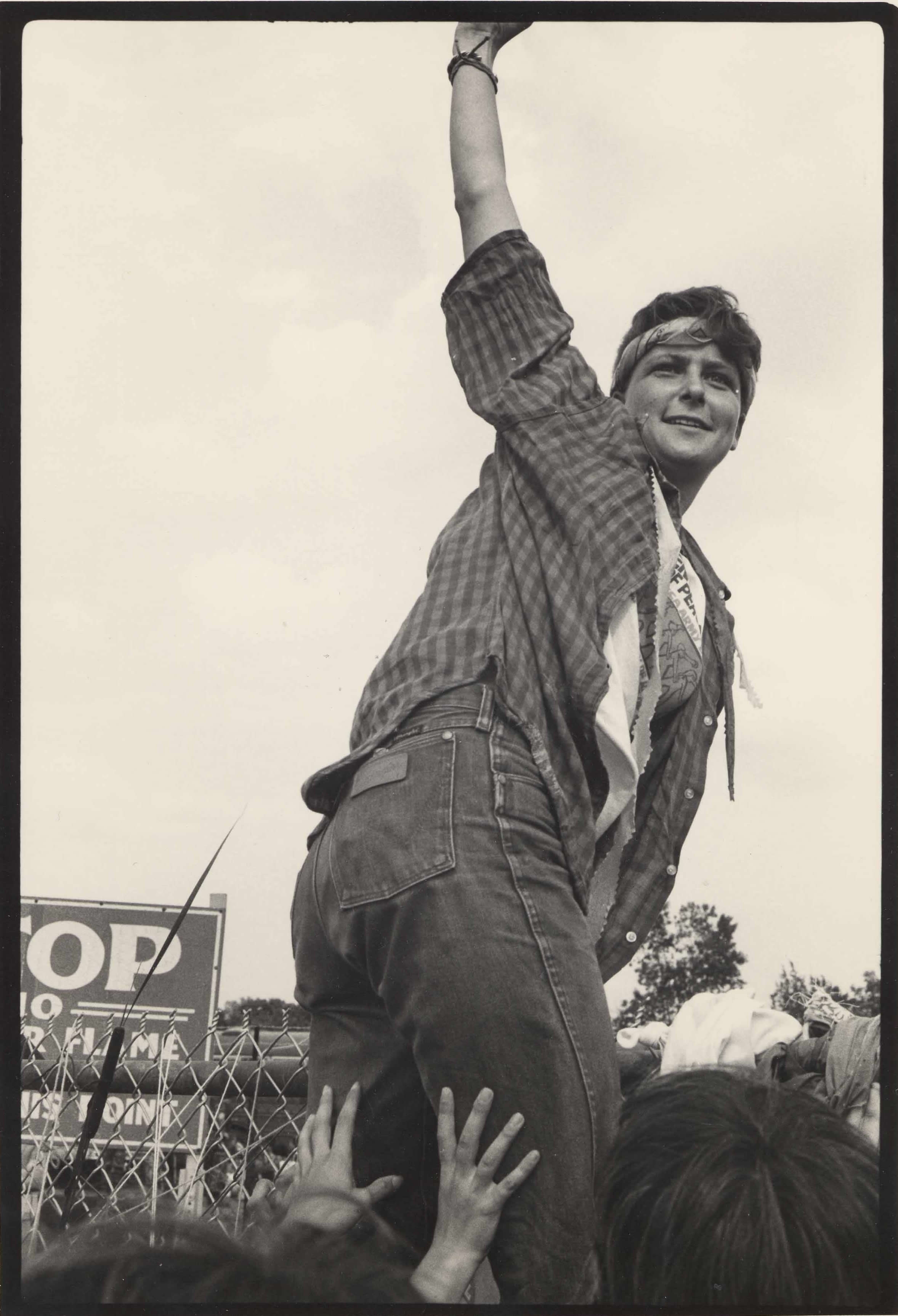
Event: Women’s Encampment for a Future of Peace and Justice,
Seneca Army Depot, Romulus, NY
August 1, 1983
6" x 9.5"
Created March
2010 by Elizabeth Matlock and Wendy Chmielewski
This file was last updated on
February 20, 2015

